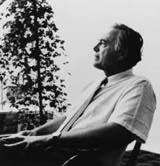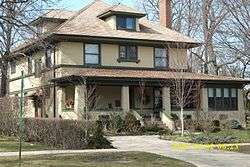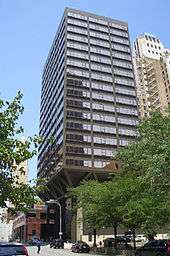Harry Weese
| Harry Weese | |
|---|---|
 | |
| Born |
June 30, 1915 Evanston, Illinois, US |
| Died |
October 29, 1998 (aged 83) Manteno, Illinois |
| Nationality | American |
| Alma mater | Massachusetts Institute of Technology (1938) |
| Occupation | Architect |
| Buildings |
Arena Stage Time-Life Building The United States embassy in Accra, Ghana |
| Projects | Washington Metro |
Harry Mohr Weese (June 30, 1915 – October 29, 1998) was an American architect, born in Evanston, Illinois[1] in the Chicago suburbs, who had an important role in 20th century modernism and historic preservation. His brother, Ben Weese, is also a renowned architect.
Early life and education

Harry Mohr Weese was born on June 30, 1915 in Evanston, Illinois as the first son of Harry E. and Marjorie Weese. His father was an Episcopalian, and his mother was a Presbyterian.[2] In 1919, the family moved to a house in Kenilworth, Illinois, where Harry would be raised. Weese was enrolled in the progressive Joseph Sears School in 1919. By 1925, Weese decided that he wanted to be either an artist or an architect.[3]
After graduating from New Trier High School, Weese enrolled at the Massachusetts Institute of Technology in 1933 to pursue a Bachelor in Architecture. Weese also took architecture classes at Yale University starting in 1936. Weese studied under Alvar Aalto at MIT and fraternized with classmates I.M. Pei and Eero Saarinen. As his schooling was at the height of the Great Depression, Weese eschewed studying the expensive historical revivals in favor of more affordable modern styles. In the summer of 1937, Weese toured northern Europe on a bicycle, fostering his appreciation for the modernist movement.[3]
Upon his return to the United States, Weese was offered a fellowship at the Cranbrook Academy of Art (sometimes called the "Scandinavian Bauhaus"[3]) through Eero Saarinen, whose father Eliel oversaw the school. There, he studied city planning, potter, and textiles while learning more about Modernist principles. He worked alongside other emerging Modernist designers such as Ralph Rapson, Florence Knoll, and Charles Eames.[3]
Career

Weese formed an architectural partnership in Chicago with classmate Benjamin Baldwin upon their graduation in 1940.[3] He would later marry Baldwin's sister, Kitty.[3] Following the brief partnership, Weese joined the firm of Skidmore, Owings and Merrill (SOM). Soon after joining, however, Weese enlisted as an engineering officer in the United States Navy for World War II. Weese moved back to Chicago after the war in 1945 and rejoined SOM.
In 1947, Weese started his independent design firm, Harry Weese Associates. His first commissions, such as the Robert and Suzanne Drucker House in Wilmette, Illinois, were houses for family members and close associates. By the late 1950s, Weese began to receive major commissions. Although he continued to plan houses, Weese also built civic projects such as the Metropolitan Correctional Center in Chicago.
The Washington Metro in the District of Columbia helped Weese become the foremost designer of rail systems during the peak of his career. He subsequently was commissioned to oversee rail projects in Miami, Los Angeles, Dallas, and Buffalo. He was named a Fellow of the American Institute of Architects in 1961 and received the Arnold W. Brunner Memorial Prize from the National Institute of Arts and Letters in 1964.
Weese was also well known for his firm advocacy of historic preservation and was remembered as the architect who "shaped Chicago’s skyline and the way the city thought about everything from the lakefront to its treasure-trove of historical buildings".[4] He led the restoration of Adler & Sullivan's Auditorium Building, and Daniel Burnham's Field Museum of Natural History and Orchestra Hall. Harry Weese & Associates received the Architecture Firm Award from the American Institute of Architects (AIA) in 1978. Weese also served as a judge for the Vietnam Veterans Memorial design competition, and helped defend fledgling architect Maya Lin's unconventional design against her critics.[1]
From the mid-1980s, Weese drank heavily and his reputation faded; he died after years of going in and out of alcohol rehabilitation and a series of disabling strokes.[3][5][6]
Personal life
Weese's parents were Protestant Christians, but he himself was nonreligious. While being interviewed by the building committee of the Seventeenth Church of Christ, Scientist in Chicago, when asked of his religious views, he said, "My father was Episcopalian, my mother Presbyterian, and I’m an architect".[2]
Legacy
In a 1998 obituary, architectural critic Herbert Muschamp wrote that "Mr. Weese designed a systemwide network of stations that rank among the greatest public works of this century", referring to his design of the Washington Metro system. Muschamp noted that the vaulted ceilings at the crossings of subway lines "induce an almost religious sense of awe".[1]
In 2007, the design of the Washington Metro's vaulted-ceiling stations was voted number 106 on the "America's Favorite Architecture" list compiled by the American Institute of Architects (AIA), and was the only brutalist design to win a place among the 150 selected by this public survey. In January 2014, the AIA announced that it would present its Twenty-five Year Award to the Washington Metro system for "an architectural design of enduring significance" that "has stood the test of time by embodying architectural excellence for 25 to 35 years". The announcement cited the key role of Harry Weese, who conceived and implemented a "common design kit-of-parts" which continues to guide the construction of new Metro stations over a quarter-century later.[7]
Works

Weese is best known as the designer and architect of the first group of stations in the Washington Metro system. Other well known works include:
- Robert and Suzanne Drucker House in Wilmette, Illinois
- Alpha Sigma Phi, Alpha Xi Chapter House at Illinois Institute of Technology in Chicago, Illinois
- The United States Embassy Building in Accra, Ghana
- Arena Stage, Washington DC
- Time-Life Building, Chicago, Illinois[4]
- First Baptist Church, in Columbus, Indiana
- Seventeenth Church of Christ, Scientist in Chicago, Illinois
- The Marcus Center for the Performing Arts in Milwaukee, Wisconsin
- The 411 East Wisconsin Center, also in Milwaukee
- The Humanities Building at the University of Wisconsin–Madison, widely considered one the Midwest's best examples of brutalist architecture but slated for demolition soon.
- The Chazen Museum of Art at the University of Wisconsin–Madison, formerly known as the Elvehjem Museum of Art
- The Upper School (high school) building of The Latin School of Chicago in Chicago, Illinois
- Pierce Tower, an undergraduate residence hall at the University of Chicago
- Mercantile Bank, Kansas City, Missouri
- Westin Crown Center Hotel, Kansas City, Missouri
- The former US Embassy to Ghana in Accra
- Fulton House at 345 N. Canal Street in Chicago. Converted 19th century 16-story cold-storage warehouse building to condominium building.
- Fewkes Tower at 55 W. Chestnut Street (formerly 838 N. Dearborn Street) in Chicago[8]
- River Cottages at 357-365 N. Canal Street in Chicago. Sloped, structurally expressive facade responds to the angle and cross bracing of the railroad bridge directly across the river.
- William J. Campbell United States Courthouse Annex in downtown Chicago (formerly known as the Metropolitan Correctional Center, Chicago.) Federal temporary holding prison which has no window bars, instead each cell is provided with a vertical 5" slot window. Weese was mandated to follow then new federal prison architectural guidelines, like cells having no bars and by original design each prisoner had his own room.[9][10]
- Middletown City Building, Middletown, Ohio
- Formica Building, Cincinnati
- Sterling Morton Library, The Morton Arboretum
- O'Brian Hall at the State University of New York at Buffalo
- The Healey Library at the University of Massachusetts Boston
- The Given Institute, Aspen Colorado
- St. Thomas Episcopal Church, Menasha, WI. A striking building, similar to the aforementioned First Baptist Church in Columbus, IN, but with an even more sweeping roof design and towering steeple.
- Swissôtel Chicago, Chicago. The cross-section is an equilateral triangle, so that two-thirds of the rooms have a view of the main stem of the Chicago River.
Weese also led numerous restoration projects including:
- Louis Sullivan's Auditorium Building in Chicago, Illinois (1967)[4]
- Field Museum of Natural History, Chicago, Illinois[1]
- Orchestra Hall, Chicago, Illinois[1]
- Union Station, Washington DC[1]
And 80+ single home and residential buildings including:
- His primary residence in Barrington , Illinois
- "Shadowcliff", Ellison Bay, Wisconsin
- Evanston, Illinois
- Glen Lake, Michigan
- Muskoka Lakes, Ontario, Canada
- Red House, Barrington, Illinois
- Wayne, Illinois
References
- 1 2 3 4 5 6 Muschamp, Herbert (November 3, 1998). "Harry Weese, 83, Designer Of Metro System in Washington". New York Times. Retrieved 2016-02-15.
- 1 2 "Real Estate And Religion: The Tale Of Seventeenth Church Of Christ, Scientist | WBEZ". www.wbez.org. Retrieved 2016-04-24.
- 1 2 3 4 5 6 7 Sharoff, Robert (July 7, 2010). "On the Life and Work of Chicago Architect Harry Weese". Chicago Magazine. Retrieved October 20, 2014.
- 1 2 3 "Harry Weese, Visionary Architect Known as 'Chicago's Conscience'". Chicago Tribune. November 1, 1998.
- ↑ Baldwin, Ian (May 2011). "The Architecture of Harry Weese: Chicago modernist". Places Journal. Retrieved 2016-04-16.
- ↑ Kahn, Eve M. (3 January 2011). "The Complexities of a Pioneering Architect". Architect: The Journal of the American Institute of Architects. Hanley Wood Media, Inc. Retrieved 2016-08-27.
- ↑ Mortice, Zach. "2014 Twenty-five Year Award". American Institute of Architects. American Institute of Architects. Retrieved 2014-02-11.
- ↑ "The Fewkes Tower". ChicagoArchitecture.info. October 27, 2010.
- ↑ Cf. Waldheim, p.285
- ↑ Cf. Art Institute of Chicago, transcript of oral history interview with Harry Weese. pp.179 and onwards.
Further reading
- "Biography of Harry Weese" - The Art Institute of Chicago
- Waldheim, Charles; Ray, Katerina Ruedi, "Chicago Architecture: histories, revisions, alternatives", Chicago : University of Chicago Press, 2005. ISBN 0-226-87038-3
- Weese, Kitty Baldwin, Harry Weese Houses, Chicago Review Press, August 1987
External links
- Oral history interview with Harry Weese - Art Institute of Chicago.
- Works by or about Harry Weese in libraries (WorldCat catalog)
.jpg)